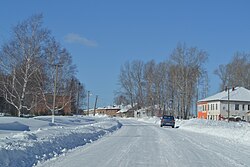Iglinsky District
Иглинский район | |
|---|---|
| Other transcription(s) | |
| • Bashkir | Иглин районы |
 Kaltova Village, Iglinsky District | |
 Location of Iglinsky District in the Republic of Bashkortostan | |
| Coordinates: 54°50′N 56°25′E / 54.833°N 56.417°E | |
| Country | Russia |
| Federal subject | Republic of Bashkortostan[1] |
| Established | January 31, 1935[2] |
| Administrative center | Iglino[3] |
| Area | |
| • Total | 2,450 km2 (950 sq mi) |
| Population | |
| • Total | 49,675 |
| • Density | 20/km2 (53/sq mi) |
| • Urban | 0% |
| • Rural | 100% |
| Administrative structure | |
| • Administrative divisions | 19 Selsoviets |
| • Inhabited localities[5] | 128 rural localities |
| Municipal structure | |
| • Municipally incorporated as | Iglinsky Municipal District[6] |
| • Municipal divisions[6] | 0 urban settlements, 19 rural settlements |
| Time zone | UTC+5 (MSK+2 |
| OKTMO ID | 80628000 |
| Website | https://iglino.bashkortostan.ru/ |
Iglinsky District (Russian: Игли́нский райо́н; Bashkir: Иглин районы, İglin rayonı) is an administrative[1] and municipal[6] district (raion), one of the fifty-four in the Republic of Bashkortostan, Russia. It is located in the east of the republic and borders with Nurimanovsky District in the north, Chelyabinsk Oblast in the east, Arkhangelsky District in the south, Karmaskalinsky District in the southwest, Ufimsky District in the west, and with Blagoveshchensky District in the northwest. The area of the district is 2,450 square kilometers (950 sq mi).[2] Its administrative center is the rural locality (a selo) of Iglino.[3] As of the 2010 Census, the total population of the district was 49,675, with the population of Iglino accounting for 33.8% of that number.[4]

